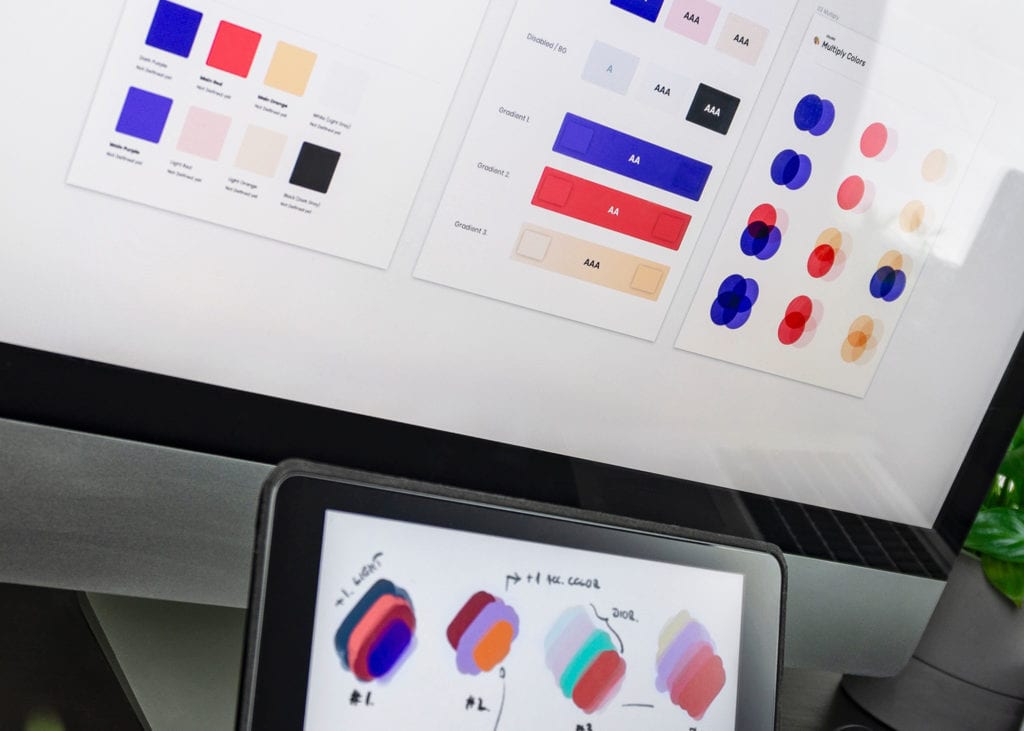
Your website is the gateway to a relationship with your company. It’s the hub, the nucleus, and it’s a digital space that can help you grow your business and increase conversions. The purpose of a website is to provide valuable information to its visitors and create a favorable impression of your company. And fortunately, it’s a straightforward process to achieve both. Once people know who you are and like who you are, they are more likely to convert. So let’s get your website in tip-top shape.
We’ll start by covering all the basic elements you need to include on your website. Then, we’ll discuss infusing your branding into your website content, both from a design and a copy perspective. We’ll make a stop at user experience, and finish with the key elements of high-quality copy. By the time we’re done, you’ll have a blueprint for website success that leads to conversions.
BUILD A STANDOUT WEBSITE
If you’ve never built a website before, it can seem daunting on the surface. All the pages and copy and design and navigation and decisions. So many decisions! You probably bounce from website to website every day, seeing plenty of examples of beautiful, shiny websites to admire from the cozy spot behind your computer screen. And you know what you’re going for; you just need a little help getting there. Your website can be one of those beautiful, shiny websites too. Let’s start with all the essential pieces you have to include on your website.
Optimize above the fold.
When you open up a website in your internet browser, everything you see before you hit the scroll bar is considered above the fold. It should come as no surprise that people like to dip before they dabble when it comes to websites, and prioritizing information above the fold ensures your visitors get the best taste of what you offer.
While the websites of the 90s and 00s jammed as much information as possible above the fold, you don’t have to follow suit. It’s true that you’ll lose people if they don’t find the information they need above the fold, but it’s a website best practice in 2021 to prioritize your information and give your visitors options for engaging further.
Think of it this way: why are people on your website? If you could tell them one thing, what would it be? What is your biggest contribution to your customers’ lives? Focus on that. Put it front and center, and then use a call to action (CTA) to lead your visitors to more information. Less is more when it comes to the websites of 2021. And visitors should land on information that directly speaks to the benefits for them. You can tell them about yourself later.
Tell your story. Show your value.
Every good website has an about page. This is your space to tell your story, and it gets a bit tricky because on the surface it may seem like it’s about you, but if you dive underneath, you’ll see it’s actually about your audience. Frame your about page in terms of the value you provide, the benefits your company offers its customers, and tell a compelling story they can’t help but want to be part of. Oh, and don’t forget to include pictures. People love visuals that illustrate your story. And you can continue telling your story over on social.
Link to social in your footer.
Most website builders include social links in the footer. Don’t skip these. While people can send you messages through your contact form (also a good thing to include on your website), they can more easily become part of your story through social media. Make it easy as pie for them to follow you. And include a newsletter signup form as well so that they can get exclusive info straight in their inbox. One note here, some people include social icons in their header - don't do this. You're inviting your website visitors to immediately leave and go somewhere else. Chances are you brought them to your site to stick around for a bit, so keep those tempting outbound social links in the footer for later.
Include your newsletter signup.
Email marketing is more lucrative than social media marketing. Yes, in 2021 this is still true. In order to reap the benefits of email marketing, you need to make it easy for people to sign up for your email list. Include an email signup form on your main webpage, and don’t complicate it. All you need is one piece of information: their email. Another must-have? A blog.
Invest in content marketing. Blogs are low-hanging fruit.
If you don’t yet have a blog, it’s time to add one. You can add posts over time, but it’s a gift that keeps giving, and there are many reasons to add one when you’re building your website. The data shows it increases conversions, website traffic, and humanizes your brand.
And if you want help building the dream website, we do custom and Express WordPress websites. We can also help you build your brand, which you will infuse into every one of these website elements.
INFUSE YOUR BRAND INTO YOUR WEBSITE
Once you have the ingredients prepared for your website, it’s time to add some spices. Think of branding like the flavor you add to a recipe. Let’s back up and talk about what branding can do for your business. Branding is your company’s personality and it’s reflected in how you live your values, how your company communicates, and how you infuse your identity into all of your assets. Yep, websites are included here.
When you have strong branding that you infuse into everything you do, you become more recognizable to customers past, present, and future. When your audience immediately recognizes your presence, it helps establish trust and familiarity, which are key ingredients for a relationship.
Branding is much more than slapping a logo on your website; think about your company’s values, role in your industry, and how you want your audience to feel when they interact with you. Use this information to guide how you build your website. If you want your audience to feel reassured when they interact with you, focus on calming design elements, empathetic copy, and user experience that’s a digital walk in the park.
MAKE IT A GOOD EXPERIENCE
When you draw up plans for your website, you have to consider user experience. Essentially, user experience is considering how your website impacts its visitors. Peter Morville designed a honeycomb to represent the key elements of user experience. According to him, visitors should find your website:
- Usable
- Useful
- Valuable
- Desirable
- Findable
- Accessible
- Credible
There are entire books on the subject, so it would be a tall order for us to review every aspect of user experience in this blog, but we have a few quick tips to get you started.
Test for responsive design.
As of February of this year, mobile website traffic is sitting at 55%, overtaking desktop traffic. And websites don’t load the same on a computer as they do on a mobile phone. When you’re going through your QA rounds before website launch, make sure you check mobile. Look for how images appear—grainy or clear, load times, and formatting.
Use visuals to enhance user experience.
Remember when Instagram first launched? It was a personal photo album that you could share with your friends. The whole platform was based around visuals, and it’s continued to focus on the human love of media with IGtv, reels, and stories. Websites need visual elements, too. To make it a good experience for your visitors, choose high-quality, optimized images that are formatted correctly. Animations, when done well, can wow visitors to your website, but you’ll need a great designer and website developer to make sure they don’t cross the line into distracting.
Make it readable.
Here's the part where we talk about text walls. While text walls are appropriate for newspapers, they definitely are not for websites. And if you have too much text on your website, you’ll lose people. You can focus on readability by including formatting elements that break up the text, like headings, subheadings, and bulleted lists. You can also go back through and remove at least 25% of what you originally wrote to make sure it’s clear and concise.
Use color to your advantage.
Color is a pretty important part of your website design and it should fall under the umbrella of your brand identity, but for the purposes of user experience, let’s talk color theory. When you think about your brand identity, consider how you want your audience to feel when they interact with you. The colors you choose to represent your company, and ultimately use on your website, can influence this reaction a lot. Does your company focus on health and wellness? Use calming, muted colors. Red can increase appetite. Do you have a meal delivery service? Include red in your color palette.
Give them something to focus on
Website design follows some of the same principles of good photography. You can use design elements on your website to guide the visitor’s eye to certain areas, or focal points. A good rule of thumb is to shift the visual focus to your call to action. To increase your visitors’ attention, include white space, or negative space. White space reduces distractions and facilitates eye movement toward focal points on the page. It’s a website best practice.
Forget the choose your own adventure
When building a website, make every part of the experience easy for your visitors. That includes navigating the website. A cardinal sin of website building is putting too much information on the website. Use other aspects of your marketing strategy—blogs, email marketing, and social media—to disseminate information over time, and keep your website clean and concise. Use tabs to help visitors find information, make sure your design and your copy follow a logical flow, and reduce extra steps.
One example: include “add to cart” buttons under product descriptions. Don’t make people sign up for anything first to get the product into their cart or click through multiple screens to finalize their purchase. Convoluted navigation can lead to the dreaded “abandon cart.” It’s too much work for a website visitor. And your copy shouldn’t make visitors work too hard either.
WRITE CLEAR AND ENGAGING COPY
Website copy can make or break your website. Truly. The first website best practice you need to know about website copy is to use search engine optimization (SEO).
Optimize your website to enhance its searchability.
To execute SEO properly, you need to understand how it works. Essentially Google has “crawlers” that go out and gather information about content available on the internet. Then the crawlers index the content they find. When you search for something in Google, an algorithm matches your search query with the content in the index.
The first step you can take is to infuse keywords and key phrases into your website copy that make it more searchable. Pretend you own a company that sells environmentally-friendly gardening equipment. You might include key terms like “environmentally-friendly,” “gardening equipment,” “gardening,” “rake,” “vegetable gardens,” and “flower gardens” in your website copy.
You also need to include alt text for your images. This is dual-purpose, helping with both accessibility and with SEO. Include clear descriptions of your images on your website’s backend and incorporate your SEO key terms into those descriptions. Including alt text will help people find your website and make your website more accessible to people with blindness. But there’s more to quality website copy than focusing on searchability. Once somebody lands on your website, it needs to be compelling, so they stay on the page.
Be clear and concise.
Website copy is a different beast than blogs. It’s short, to the point, and as clear as possible. Ask yourself, what are the least amount of words I need to get my point across? That’s website copy. As it’s many people’s entry point to your company’s story, you want to grab attention right away, keep attention, and guide visitors to their next steps. Anything extraneous has gotta go. It’s like the Home Edit, but website-style. It’s also good to ask, what has to be on the website, and what could be part of another asset or communication channel? Think of your website like the introduction and the synopsis all rolled into one.
Speak to your audience. Use their words back at them.
Your copy needs to be written for the audience. Use language they use. Speak directly to them, which means it’s totally fair game to use the second person. Kind of like we did in this blog. Get to the heart of their feelings, motivations, and pain points. Address these in your copy. Think of the Johnson and Johnson branding, “no more tears.” What does this get at? Parents hate watching their kiddos cry, and Johnson and Johnson promises a shampoo that’s safe, gentle, and won’t sting your child’s eyes. Pull at those heartstrings and show them you care and that you have a solution.
A WEBSITE THAT CONVERTS?
YES, YOU CAN!
Listen. If you follow these key website best practices, you will have the foundation for an excellent website that converts over and over. But rest assured, the best part about digital marketing is that nothing is set in stone—it all exists on the malleable internet. That means you can watch what works and make updates as you learn and grow. That’s a win-win.

Kiley
Founder & CEO
Kiley Peters is the Founder and CEO of Brainchild Studios, a boutique audience research, content strategy, and website creation agency primarily serving brands targeting Millennial Moms or business owners. She is also the Founder of the Work From Home Playbook, a series of online courses guiding aspiring entrepreneurial moms through the steps of starting a virtual business. She also launched the Brainchild Fund, a nonprofit initiative to support women and girls in business and entrepreneurship Follow her on Instagram.
more posts by Kiley →Related posts
-
 Content Marketing, SEO
Content Marketing, SEO -
 Content Marketing, SEO
Content Marketing, SEO -
 Content Marketing, Small Business
Content Marketing, Small Business -
 Content Marketing
Content Marketing -
 Small Business, SEO, Local SEO
Small Business, SEO, Local SEO -
 Content Marketing, Websites
Content Marketing, Websites -
 SEO, Websites
SEO, Websites










